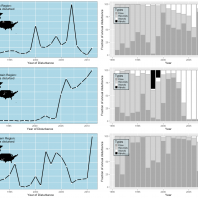A component of the US National Forest System’s NFS comprehensive plan for carbon monitoring includes accounting for mapped disturbances, such as fires, harvests, and insect activity. The NFS needs to be able to monitor the effects of management and natural disturbance upon carbon storage for proper reporting to national and international instances. To facilitate this reporting, there exists the Forest Carbon Management Framework ForCaMF, which combines disturbance maps, data from the Forest Inventory and Assessment program FIA, and empirical forest dynamic models to meet said NFS needs. Work has been conducted between the US Forest Service Rocky Mountain Research Station, and Utah State University to develop products for ForCaMF that required precise identification of the location, timing, and cause of disturbances affecting NFS forests for the period from 1990 to 2011. Our results provide objective, widely interpretable estimates of per-year disturbance across large areas. Different stakeholders (scientists, managers, policymakers) should benefit from this broad survey of disturbance processes affecting US federal forests over the last 20 years.
This project also aims to model the amount of carbon stored in forests throughout the NFS and tracks how this changes in response to disturbances. Using the disturbance maps and empirically calibrated carbon dynamics, ForCaMF provides estimates of the effect of real or hypothetical disturbance regimes on carbon storage. Monte Carlo analysis is used to provide some measure of uncertainty around these estimates.
